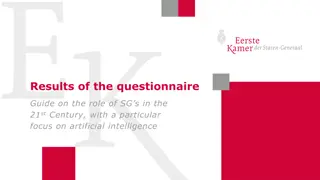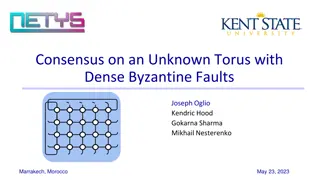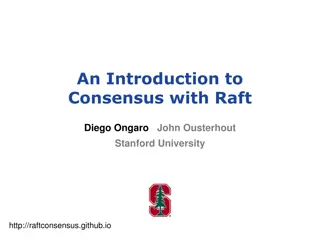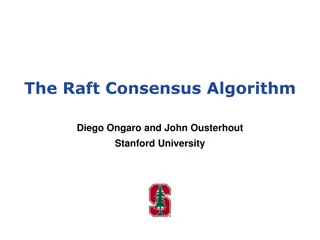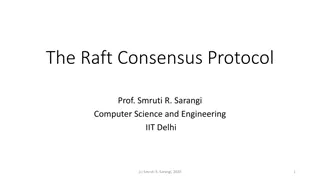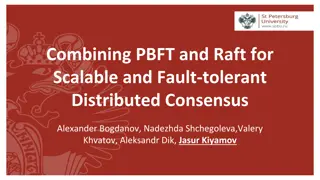Consensus in Egalitarian Parliaments: Understanding EPaxos Innovation
The presentation sheds light on achieving consensus in egalitarian parliaments through EPaxos, an innovative protocol allowing concurrent commits and orderly execution. It explains the phases of the EPaxos commit protocol in detail, emphasizing the establishment of ordering constraints and the Paxos-Accept phase for optimal replication and load balancing in distributed systems.
Download Presentation

Please find below an Image/Link to download the presentation.
The content on the website is provided AS IS for your information and personal use only. It may not be sold, licensed, or shared on other websites without obtaining consent from the author.If you encounter any issues during the download, it is possible that the publisher has removed the file from their server.
You are allowed to download the files provided on this website for personal or commercial use, subject to the condition that they are used lawfully. All files are the property of their respective owners.
The content on the website is provided AS IS for your information and personal use only. It may not be sold, licensed, or shared on other websites without obtaining consent from the author.
E N D
Presentation Transcript
There is more Consensus in Egalitarian Parliaments Presented by Shayan Saeed Used content from the author's presentation at SOSP '13 http://sigops.org/sosp/sosp13/talks/morar u_epaxos_se07_03.pdf
Motivation State Machine Replication Optimal Commit latency for Wide Area Optimal Load Balancing for high throughput Graceful Performance Degradation for slow or failed nodes Paxos and its variants widely used Pre-ordered instances Choose commands for each slots 2 rounds to commit a command Elect a leader to get the slot Propose the command to all the replicas Even more rounds for dueling leaders
Ordering of Instances Compete for slots Paxos Vote Vote Vote ACK ACK Leader decides for slots - Multi-paxos Me Me Me
Ordering of Instances cont. Pre-distribute slots among replicas Mencius Drawbacks 2 RTT for Paxos more for dueling leaders Multi Paxos Leader is bottleneck, leader re-election problem, leader can be far so high latency Mencius communicate to all the replicas, speed of the slowest replica, bad availability on failure
EPaxos Innovation B C A D Every replica can commit concurrently Notes dependencies before committing Executes them in order 2 RTT only for concurrent and interferring commands small chance C D A B
EPaxos Commit Protocol Phase 1: Establish Ordering Constraints A replica L receiving a command C from client: Prepare a list dep of all instances whose commands interfere with C. Calculate seq greater than that of all interfering commands in dep. Send (C,dep,seq) to other replicas in a PreAccept message. Any replica R on receiving PreAccept message: Update dep and seq according to its own command log. Record C and new attributes in command log and send it back. If L receives enough replies and all attributes are the same, it will move to commit phase. Otherwise it goes to Paxos-Accept Phase
Phase 2: Paxos-Accept Phase If the attributes in some replies are updated differently than in others: Take union of all deps and choose highest seq and update attributes. Tell the replicas to accept these attributes. After hearing back from a majority, move on to the commit phase. Phase 3: Commit Phase Log the command as committed. Reply back to client notifying the commit. Send commit messages asynchronously to all the replicas.
EPaxos in Action C2: Update obj_A ACK C2 Pre-Accept C2 Accept C2 R1 Commit C2->C1 C2 -> C2 -> C2 -> C1 ACK R2 C2-> C1 ACK R3 R4 C1 -> C1 -> R5 Commit C1-> Pre-Accept C1 ACK C1 C1: Update obj_A
EPaxos Execution Algorithm After the instance gets committed, following execution algorithm is run for a command C: Build dependency graph for command C and recursively for all nodes in there Find strongly connected components (where every component is reachable from other), sort them topologically It will be a DAG now. In inverse topological order, for every strongly connected component Sort all commands in the component by their sequence numbers Execute all the commands in increasing sequence number order
Execution A 1 E C B 2 D E D 3 C,A,B Strongly Connected Components
Failure Recovery Explicit Prepare Replica Q, after timing out for instance L.i to commit for a failed replica L will: Send Prepare to all replicas with ballot greater than L.i and wait for replies R. If any reply says instance committed, run commit phase. If any reply says instance accepted, run Paxos-Accept phase. If more than half replicas have pre accepted, run Paxos-Accept phase. If any reply has pre accepted then run phase 1. Otherwise make that instance a no-op
Discussion Determining whether the commands interfere Process might be expensive if log is huge If you can t, assume all the commands as interfering Latency and throughput almost same as Mencius Size of dependency list? Only include commands that interfere directly Process cumbersome for ordering dependencies and execution Prioritize processing old commands over new ones O(n) for highly connected components and O(log n) for sorting by sequence no.
Discussion Read leases effect on writes? All the writes routed to the node holding read lease What would the effect be if leasing node is slow or far? Results shown only for 3 and 5 replicas for which EPaxos optimal. How would it compare for more?
Replicated Commit Nick Ciaglia
Review Atomicity o Transaction is all-or-nothing Consistency o Transactions will only bring the database from one valid state to another Isolation o Concurrent execution gives the same answer that serial would have Durability o Once a transaction has been committed, it will remain so. Even in the case of system failure.
Background Traditional Relational Databases not good enough anymore? o Cassandra, Dynamo, Bigtable don t guarantee isolation or atomicity o SQL Azure, NoSQL, Megastore only guarantee subsets of database Spanner, Scatter o Two-Phase Commit, Two-Phase Locking, Replicated Paxos Log
Replicated Log (Spanner, Scatter) Between 7 and 8 cross- datacenter trips o While holding locks Uses Multi-Paxos o Removes the need to elect leader every run
Motivation Cross-Datacenter communications costly o Google: 0.5 second increase in search page generation time causes traffic to drop 50% o Amazon: Every 100ms increase in latency results in 1% loss of sales Who Cares? o Packet sent from East to West coast takes nearly 45ms
Replicated Commit Reduce the number of cross-datacenter trips as much as possible o Replicate commit itself, rather than logs Continue to ensure ACID Remain agnostic to relational or key-value High scalability
Basic Paxos Review Players o Proposer - Entity that advocates a client request o Acceptor - Accepts proposals o Learner - Learn the value that majority of acceptors accepted Phases o Phase 1 - Acceptors vote for leader <-- We can skip this! o Phase 2 - Acceptors accept value proposed by the leader o Phase 3 - Learners learn it
How We Use Paxos Proposer: The Client Acceptors/Learners: Each datacenter No need for election phase since there s only one Proposer Value to agree on: whether or not to commit o Default is don t commit
Avoiding Deadlocks If lock cannot be granted, request is denied o No hold & wait Write lock can take over existing read lock
Comparisons Replicated Log Requires reads from Paxos leader, which is arbitrarily far from client Re-electing leader can take entire seconds(!) 7-8 Cross Datacenter Trips Replicated Commit Only requires majority of replicas at different datacenters up and running Once majority respond, any further communication is done behind the scenes 2-4 Cross Datacenter Trips o 6-7 fewer trips total while holding locks
Experiments 5 Datacenters o California (C) o Virginia (V) o Oregon (O) o Ireland (I) o Singapore (S) Three different servers per center o Each responsible for independant shard of data o Three unique shards (X, Y, Z)
Experiments (Commit Latency) Considerably faster o Especially when further apart
Latency Analysis With N datacenters, Replicated Commit will perform better as long as there are < 2.5N reads per transaction o Trade-off between read and commit latency
Experiments (# Ops) Recall: 2.5N is the magic number Replicated Log (RL) should overcome Replicated Commit (RC) at 12.5 Ops/txn o Half operations are write, so the crossover at 25 is perfect Analysis works (go figure)!
Experiments (Throughput) Throughput = Number of successfully committed operations per second. Avoids thrashing due to no contention among leaders (no leaders!)
Thoughts Simple deadlock avoidance strategy o Leads to traffic asking for same resource multiple times or never getting it o Rests on developers shoulders Degenerates with increasing read/transaction o Relational Databases are inherently high-read constructs o Could this be avoided? Would like to see bigger tests
Improvements Bounded by the slowest datacenter in majority for reads o Could be optimistic: return the first you see o Requires more logic if something turns out incorrectly More scalability tests
Source http://www.vldb.org/pvldb/vol6/p661-mahmoud.pdf





